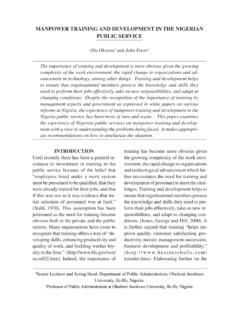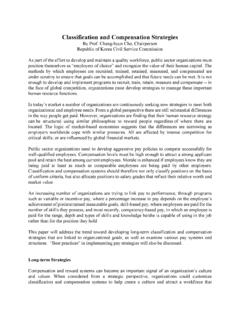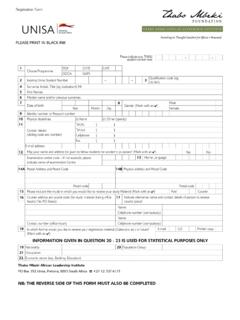Transcription of Planning for Service Delivery Improvement - United Nations
1 IssuesSDR Vol 5 No 2 2006106In his 2004 State of the NationAddress, President thabo mbeki said: We must be impatient with those inthe public Service who see themselves aspen-pushers and guardians of rubberstamps, thieves intent on self-enrich-ment, bureaucrats who think they havea right to ignore the vision of BathoPele, who come to work as late as possi-ble, work as little as possible and knockoff as early as possible. Since 1994 the democratic govern-ment has targeted the acceleration ofservice Delivery to communities. This isseen as necessary to eradicate inequali-ties that are a result of our past. Themajor policy instrument in this regardhas been the White Paper on theTransformation of the Public Servicepublished in policy sets out eight transforma-tion priorities, among which transform-ing Service Delivery is regarded as this transformation priority theWhite Paper on the Transformation ofService Delivery published in 1997(Batho Pele) was developed to provide apolicy framework and practical imple-mentation strategy for the improvementof Service Delivery .
2 The White Paper on TransformingService Delivery recognises that ourservice Delivery machinery of the pastwas: Inefficient and ineffective; self-serving, inward looking, bureau-cratic, fragmented and over-cen-tralised; inequitable, discriminatory, lackingdiversity and demographic represen-tation; prescriptive, rule-bound, too compli-ance oriented, top-down (and topheavy); and corruption countering these negative legacies,the White Paper therefore declared thatthe public Service should be people-cen-tric. It set out our responsibility in thesocial contract of giving effect to a devel-opmental state through fostering trans-formation of the public Service for abetter life for all.
3 This would require the re-engineer- Planning for ServiceDelivery ImprovementJohan Neldetails theplans for the vital taskof improving servicedelivery and the toolsavailable to do thisSDR Vol5 No2 11/17/06 12:27 PM Page 106 IssuesSDR Vol 5 No 2 2006107ing of both the back and front office;and fostering an external and internalculture of communication which wouldensure effective, efficient Service deliv-ery - thus making Batho Pele a Delivery improvementdimensionsThere are two dimensions of servicedelivery Improvement . The first is insti-tutional performance. The focus here isimproved performance in the applica-tion of policies, efficient systems,processes, organisation, technology,infrastructure (including way findingand signage) and second dimension is at the indi-vidual performance level.
4 Here, therehas to be accountability that is linked tojob descriptions and delegation ofauthority, education and training, com-mitment to delivering services, ethicalconduct, effective placement in bothback and front office, and appropriateperformance management in areas ofrewards and Delivery ImprovementProgrammeService Delivery ImprovementProgramme (SDIP) should be seen aspart of strategic Planning . It is a contin-uous process that runs in cycles, similarto strategic Planning . It focuses on thestrategies to bring the Batho Pele princi-ples to life and make improved servicedelivery a reality. It is a requirement in terms of Part Cof the Public Service Regulations of2001.
5 The programme must be imple-mented, monitored and reported is no prescribed format toSDIP. It can be an integral part of adepartment s strategic and operationalplans, or it can be a separate contents of the SDIP are prescribedby the Public Service Regulations. The SDIP has a range of these objectives, the SDIP aims to facilitate Service Delivery accord-ing to measurable standards. It alsoseeks to ensure that we treat servicerecipients as customers. In this sense, it seeks to protect cus-tomer s rights and enhance the relation-ship between the public Service and itscustomers. Furthermore, it seeks totransform the public Service frombureaucracy to a results-driven organi-sation delivering on the government ssocial contract with the SIDP should contain the differ-ent types of actual and existing cus-tomers that are identified.
6 It should alsocontain the main services to be providedto the above customers. Also to beincluded is the consultation arrange-ment with the customers specified, withthe means of access to services and thebarriers to access specified, as well as thestrategies to remove the barriers speci-fied. Moreover, the existing and futureservice standards for the services to bedelivered must be specified togetherwith arrangements on how informationabout the department s services is pro-vided. Lastly, the SDIP should contain asystem or mechanisms for managing thecomplaints of customers. SDR Vol5 No2 11/17/06 12:27 PM Page 107 IssuesSDR Vol 5 No 2 2006108 The SDIP must identify the types ofexisting and future customers for eachservice which might include internal,external, individual, institutional cus-tomers, and customers in terms of geo-graphical boundaries.
7 Services to be provided to the abovecustomers need to be identified. Themain services provide the justificationfor the existence of the department andare normally contained in legislativemandates. The main services can be divided intocore and support services. Core servicesare generally delivered to external cus-tomers through the front office. Supportservices are generally delivered to assistthe front office and are provided by theback front office Service deliveryrepresents the face of the department tothe customer, back office services are notless SDIP should specify the consul-tation arrangements with the should devise different means of con-sultation with customers. Workshops,imbizos and customer surveys are exam-ples.
8 Instances of consultation should bedone at local levels. There should be abrief description of the consultationagenda - focusing on whether it is con-sultation on Service Delivery needs, stan-dards, or feedback on previous consulta-tion. It should also provide a consulta-tion should specify the means of access toservices and the barriers to access, aswell as the strategies to remove the bar-riers. Also specified should be physicalaccess to Service Delivery Service points -stating geographical location, address ofown Service points and partner servicepoints. It should identify virtual servicepoints whether it is websites or cell-phones and mobile Service points statingthe Service area and schedule of to access, such as distance, com-puter literacy, poverty and so forth,should be identified and strategies toremove these barriers identified.
9 These strategies could include expan-sion of Service points, improved use of e-government, mobile services, outsourc-ing, partnering and so SDIP should further specifyexisting and future Service is very important. We mustremember that if it cannot be meas-ured, it cannot be improved . In thisarea, there is a need to start with achiev-able standards and targets for services may be diverse,they all conform to generic, measurablecriteria in terms of quantity, quality,access, cost or value for money and time-lines - referring here to waiting periodsfor services from application to conclu-sion, and providing the Service on time. It should also specify the existing andfuture arrangements on how informa-tion about the department s services isprovided.
10 The objective here is to pro-vide an indication of how these arrange-ments will be improved on an annualbasis. The following arrangements areoptional: directory of services through bookletsor brochures; websites; call centres; information and help desks at servicepoints; and advertisement in the , the SDIP should specify thesystem or mechanisms for managing thecomplaints of customers. There is nosense in having a system or mechanismfor lodging complaints if complaints arenot managed in a speedy and objectivemanner. Effective management of complaintsis key to the quality criterion of settingservice standards. On-line complaintslodging systems, free hot lines, dedicat-ed customer relations staff, and helpdesks are some of the effective ways ofmanaging complaints.















